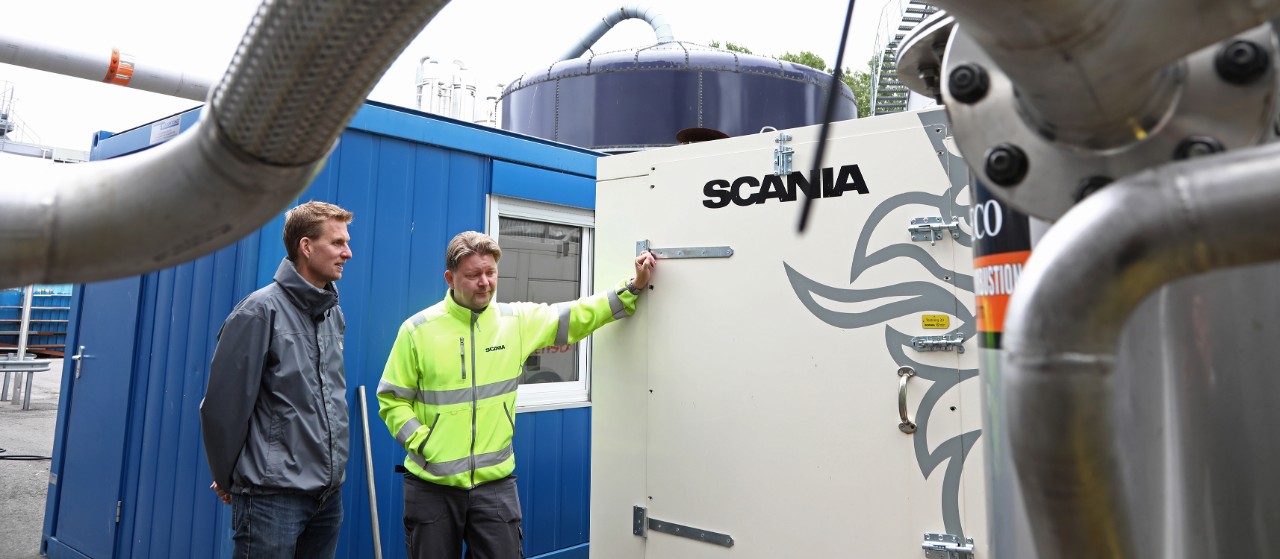
Scania engines being tested with raw untreated biogas
5 MARCH 2018
Scania Engines is collaborating with Swedish municipal waste energy producers on innovative biogas trials.
Producing biogas from waste materials for use as vehicle fuel and heating is not new. And Scania has been working with biogas as an alternative and sustainable source of energy for some years now. However, a couple of innovative trials that the company is involved in could develop the technology even further for power generation.
In collaboration with Linköping-based energy recovery specialists Tekniska verken, Scania Engines is currently testing one of its engines using raw gas, biogas that is “untreated”. That means it is not cleaned or upgraded to remove wastewater, carbon dioxide and other particles, as happens with the production of compressed natural gas for vehicle fuels. Instead, it is taken directly from the digestion chambers, which break down the organic waste to be used in its raw state as fuel for the Scania engine, to see how it performs over 600 hours of tests.
Hoped-for results of raw biogas solution
Scania’s hope is that if the engine can work with this raw gas, it will be an even quicker and cheaper process of producing biogas for power generation, and another valuable source of alternative energy from recycled material.
The idea is still very much at the experimental stage, though, as Holger Mattsson, Project Coordinator at Scania Engines, explains.
In collaboration with Linköping-based energy recovery specialists Tekniska verken, Scania Engines is currently testing one of its engines using raw gas.
“We have been working with Tekniska verken for the past two years, initially with compressed natural gas, and we started testing raw gas in early 2017,” he says. “In September 2017 we carried out the latest round of testing and have been reviewing the results during the following months.”
Scania and Tekniska verken join forces
Erik Nordell is the Development Engineer at Tekniska verken who has been coordinating the work with Mattsson and his Scania team. He has enjoyed the collaboration, which came about when Scania approached Tekniska verken as Sweden’s biggest producer of biogas, which meant it could easily spare five percent of its production capacity.
“We are very satisfied with the collaboration, as it has been very easy to work with Scania,” he says. “Whenever we have had a problem we have solved it together without any issues. It was a good experience to work with a company that is a leader in Sweden and in Europe for power generation.”
Tekniska verken excels at producing compressed natural gas (CNG) to be used as vehicle fuel. Indeed, the city of Linköping, which owns the company, runs its bus system exclusively on CNG. But while Tekniska verken’s focus is not necessarily on raw gas, Nordell says it will be taking a close interest in the results of the tests.
“We thought this was interesting,” he says, “and we wanted to learn how it could work with this type of biogas, so we will see how the results of the tests turn out.”
Telge Återvinning tests use of landfill gas with Scania
Even closer to home, Scania is also set to work with Telge Återvinning in Tveta, Södertälje, a waste-recycling entity owned by Södertälje council. At Scania’s instigation, the pair run tests to see how Scania’s engines can run on simple gas – in other words, gas that is extracted directly from landfill sites.
This will mean taking the gas directly from source without refining or upgrading it by drilling holes directly into Telge’s landfilled waste. Even though Tveta stopped taking landfill in the 1990s, the biogas by-product from the organic waste digestion process continues to be available for up to 30 years after burial.
Mattsson is excited about the Tveta test possibilities. “There are landfill sites all over the world,” he says, “and if we can effectively use the lower-quality gas that comes directly from these sources, there is huge potential for the market and for consumers.”
ENGINE TYPE
- Scania 16-litre V8, made for low-pressure compressed natural gas for power generation. Switchable between 1,500/1,800 r/min in power nodes between 333 kW and 426 kW prime power.
- COP (continuous operating power): 330 kW (50 Hz), 350 kW (60 Hz).
- Gas feed pressure: 50 mbar.